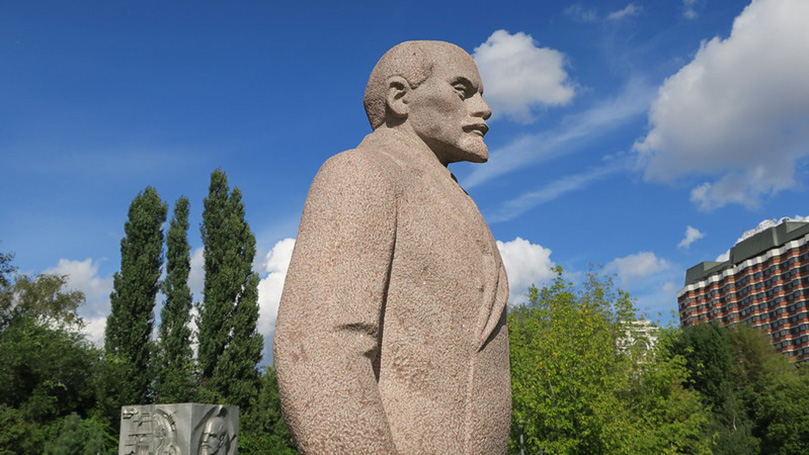
A few years back, the controversial late Italian communist philosopher Domenico Losurdo argued (in Lenin Reloaded) that the central cause of the split between the 2nd International and the 3rd International lay not precisely with the issue of reform versus revolution. Instead, Losurdo argued, 2nd International adherence to a white supremacist imaginary about “barbaric” denizens of the colonized world and the progressive role of colonialism in the “uplift” of the world’s peoples of color drove V. I. Lenin and his supporters to make their break.
Losurdo characterized the conservative side of this split as adhering to the racial concept of “herrenvolk democracy” or the belief that one’s racial community, in its inherent biological or cultural or civilizational superiority, is alone worthy of the benefits of socialistic equality. “Herrenvolk democracy” served as the basis of white supremacy in settler-colonial societies such as the U.S., Canada, and Australia and would underpin the racial theories of the Nazi regime in the 1930s.
Lenin vigorously resisted this racist dogma, which seemed to infuse the ideas and politics of the 2nd International social democrats as well as the imperialist forces. He equated the socialist version of this creed with bourgeois ideologies of national chauvinism, the erasure of revolutionary class struggle, reformism, and the labor aristocracy. He regarded it as the source of disempowering divisions within the international working class. By the early 1920s, Lenin’s appeals to white U.S. socialists and communists to oppose white supremacy and to address their own, as well as U.S. systemic, racism finally resulted in a transformation in how Marxists fought it.
By that time, however, Lenin had long understood the particular racist oppression under which African Americans struggled.
In a 1914 pamphlet, he argued for the right of nations to self-determination, that is, the right to secede from “oppressor nations,” the right to establish their independent nation-states, the right to full equality within any particular polity, and the elimination of all privileges based on national identity or religious identity.
Lenin saw these principles as the basis of full working-class democracy, which would lay the foundation for more advanced class struggle.
The right to secede from the colonial domination of an “oppressor nation” did not, however, infer working-class support for any nationalism or nationalist ideology. The socialist duty, Lenin argued, of the proletariat remained its international alliance or “amalgamation” of all workers in the joint struggle for full democracy, full equality, and socialism.
When workers refused to shed nationalist prejudices or privileges based on identity, they allowed themselves to be drawn into the hegemonic orbit of the ruling class in their country rather than their correct place in the international alliance of workers. Such a disastrous choice aborted their liberation and class destiny, as well as those of the colonized peoples of the world.
So, how does Losurdo get from this, Lenin’s discourse on national self-determination, to a critique of racism and white supremacy?
In the essay to which I refer, Losurdo doesn’t develop the discussion much and raises as many questions as he answers. So, here I will follow more of Lenin’s thoughts on nationalism and self-determination to explore the idea.
A couple of months before writing The Right of Nations to Self-Determination, Lenin published a lengthy essay over three months in the journal Prosveshcheniye titled “Critical Remarks on the National Question” (1913). In that article, he criticized liberal, democratic, and nationalistic ideologies that seemed to threaten working-class unity and a broader united front for democracy.
While most of his arguments focused on Eastern Europe, explicitly denouncing “Great Russian” chauvinism and anti-Semitism, he also deployed an essential example from the U.S. that is worth pondering.
He called for his party to reject forced assimilation of national minorities through educational schemes or coercive measures to suppress their languages and cultures. At the same time, he criticized “cultural autonomy” schemes, especially those ginned-up by intellectuals or elites within the oppressor nation. Such projects seemed intent on segregation and the creation of second-class status for national minorities. “In practice, the plan for ‘extra-territorial’ or ‘cultural-national’ autonomy could mean only one thing: the division of educational affairs according to nationality,” he wrote. He added that cultural-national autonomists within oppressed nations who supported such ideas amounted to traitors who encouraged the same segregationist concept.
Essentially, by fostering a classless nation idea and thus dissolving the alliance of workers in the oppressed nation with workers in the oppressor nation, most nationalisms weakened the struggle for full democracy. And working-class internationalism and the most comprehensive democracy were essential features of the more advanced class struggle for socialism.
To develop this argument, Lenin cited the example of Jim Crow segregation in the U.S. South:
In the United States of America the division of the States into the Northern and Southern holds to this day in all departments of life; the former possess the greatest traditions of freedom and of struggle against the slave-owners; the latter possess the greatest traditions of slave-ownership, survivals of persecution of the Negroes, who are economically oppressed and culturally backward (44 percent of Negroes are illiterate, and 6 percent of whites), and so forth. In the Northern States Negro children attend the same schools as white children do. In the South there are separate ‘national,’ or racial, whichever you please, schools for Negro children. I think this is the sole instance of actual ‘nationalization’ of schools.
First, this statement is notable in that his reference to Jim Crow segregation highlighted the nature of racist segregation and its imposition of oppressive and exploitative conditions for Black people that linked the South to its worst traditions of slavery.
On its face, even with its rosy, even inaccurate, picture of Northern society, it is an indictment of white supremacy.
Second, in the penultimate sentence, Lenin slips easily between the categories of nation and race. The word or after the adjective national that links it to the word racial suggests the equivalence of those two terms in the author’s mind. In constructing his sentence in this fashion, Lenin, who offers no specific or detailed analysis of characteristics of “nations” or “races” in the U.S. context, implies that Southern whites comprise the oppressor nation. In contrast, Southern Blacks, approximately 9 of 10 Black people in the entire U.S. at the time and about 4 in 10 southerners, are an oppressed nation. His statement characterizes Jim Crow laws and customs as coercive tools of that oppression and sets Southern Blacks forward as potential candidates for national self-determination.
Further, it positions the white section of the working class in the position of making a critical choice. Either it could side with the white bourgeoisie as participants in the white supremacist oppressor nation, or resist, build meaningful international alliances with oppressed Black workers and peasants and wage a class struggle against the exploitative class and oppressing nation.
By inserting this specific example of national oppression into his discussion of self-determination, Lenin is pointing at the working-class’s revolutionary duty to fight racial, or “national,” privilege; to demand full equality as foundational to full democracy; to reject forced assimilation of racial, or “national,” minorities; to enforce “absolute tolerance” for cultural differences among the multinational working class; and to wage a consistent battle against racism, or “national” chauvinism, within the minds and actions of the revolutionary working-class members of the oppressor race, or “nation.”
What do his words mean for us in the present? What would he say about the festering white nationalism and white supremacy that continue to shape U.S. politics, economics, and culture today?
Image: Terrazzo, Creative Commons (BY 2.0).


 Join Now
Join Now